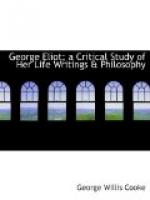that she actually copied in
Adam Bede the history
and sermons of Dinah Morris. [Footnote: “Dinah
Morris and Elizabeth Evans,” an article by L.
Buckley in The Century for August, 1882.] During visits
to her aunt in 1842 we are told they spent several
hours together each day. “They used to go
to the house of one of Mrs. Evans’s married
daughters, where they had the parlor to themselves
and had long conversations. These secret conversations
excited some curiosity in the family, and one day
Mrs. Evans’s daughter said, ’Mother, I
can’t think what thee and Mary Ann have got
to talk about so much.’ To which Mrs. Evans
replied, ’Well, my dear, I don’t know what
she wants, but she gets me to tell her all about my
life and my religious experience, and she puts it all
down in a little book. I can’t make out
what she wants it for.’ While at Wirksworth,
Miss Evans made a note of everything people said in
her hearing; no matter who was speaking, down it went
into the note-book, which seemed never out of her
hand. These notes she transcribed every night
before going to rest. After her departure Mrs.
Evans said to her daughter, ’Oh dear, Mary Ann
has got one thing I did not mean her to take away,
and that is the notes of the first sermon I preached
on Ellaston Green.’ The sermon preached
by Dinah on Hayslope Green has been recognized as one
of Mrs. Evans’s.” The purpose here
seems to be to convey the impression that George Eliot
actually carried away one of Mrs. Evans’s sermons,
and that she afterwards copied it into
Adam Bede.
George Eliot’s own positive statement on this
subject ought to be sufficient to convince any candid
mind the sermon was not copied. The evidence brought
forward so far in regard to the relations of Dinah
Morris to Elizabeth Evans is not sufficient to prove
the one was taken from the other. George Eliot’s
declarations, written soon after
Adam Bede was
published, when all was perfectly fresh in her mind,
and after her relatives had made their statements
about Mrs. Evans, ought to settle the matter forever.
Unless new and far more positive evidence is brought
forward, Dinah Morris ought to be regarded as substantially
an original creation.
That some features of Elizabeth Evans’s character
were sketched into that of Dinah Morris seems certain.
It is also said that the names of Mrs. Poyser and
Bartle Massey were the names of actual persons, the
latter being the schoolmaster of her father.
As showing her power of local coloring, Miss Mathilde
Blind relates this incident: “On its first
appearance, Adam Bede was read aloud to an
old man, an intimate associate of Robert Evans in
his Staffordshire days. This man knew nothing
concerning either author or subject beforehand, and
his astonishment was boundless on recognizing so many
friends and incidents of his own youth portrayed with
unerring fidelity, he sat up half the night listening
to the story in breathless excitement, now and then
slapping his knees as he exclaimed, ’That’s
Robert, that’s Robert, to the life.’”




